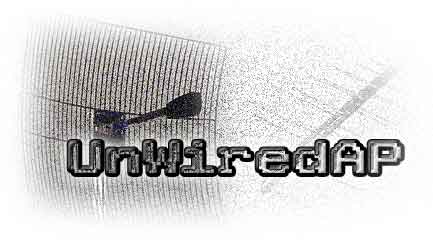
This site is a work in progress that hosts the UnWiredAP floppy linux distribution project.

This site is a work in progress that
hosts the UnWiredAP floppy linux distribution project.
| General | UnWiredAP is the most basic
form of a linux distro that houses what is needed to create a
Wireless Access Point. It's created to be used for the SWN
initiative. (Hail SWN!!) The main objective of this project is to end up with one floppy that boots on any computer (over 386), configures its interfaces (ppp, nics, wlans, etc) and runs the hardware as a full blown wireless access point (or better...). All this in a single floppy!!! Yes, I know.. No, I'm not crazy. (Really!!) The easiest way to do this is to use the wonderful hostap drivers from Jouni Malinen (jkmaline@cc.hut.fi). The problem is that these drivers only support Prism 2/2.5 chipset based cards (pcmcia or otherwise) and it doesn't seem to broaden the range of supported chipsets in the near future, since they are depended on its specific features. :( Size does matter in this project, so it's very important to minimize the size of everything in the floppy, including of the kernel image. This is done by selecting only the most important features to put in the kernel and by using UPX (note: use version 1.11 to compress kernel images, it's the only one that works. Thanks floppyfw!). UPX is an executable compression tool that works for many os'es/platforms including linux (i386). It saved me 80k off the kernel gzipped image. I planned to use it on the executables that where put into initrd, but they didn't work(!!) If anyone has any success,mail me! Since there is no support for bunzip2 in the initrd unpacker in the kernel yet, I have to 'gzip -9' the initrd. For those who don't know, initrd is an image of a filesystem (ext2 in our case) that is loaded into memory as a virtual hard drive (ramdisk), that has all the libraries and executables to run our OS (linux). Modules are another think to consider. Due to size limitations, only the most needed modules are stored and used in this floppy. uClibc is used instead of the standard libc library that programs need to run, to minimize even more the size of initrd and still keep a very good functionality level. Simplicity is another factor that is important in this project, so I use the KISS idea (Keep It Simple Stupid!). Any configuration files are stored in the floppy, not inside initrd.gz, where it's easy to change them. For now, there are only some very basic configuration scripts and files in the config folder:
For now, there is only one floppy image
that contain the following:
The disk image is a 1722k image. Almost
all disk drives support the 1722K disk and since it provides more
space, it's the preferred choice for now.
|
| Installing UnWiredAP | You can download the latest
version of UnWiredAP from here. In order to put it on a floppy in Windows or DOS you'll need Hd-copy or a version of rawrite. (I'd suggest Hd-copy, because it can handle 1722K images). Use it to format and copy the image to the disk. On linux:
You now have a disk with UnWiredAP and a collection of modules allready preinstalled:
You should now copy any additional modules you want into the "modules" folder of your UnWiredAP floppy. Select the modules you need to use your hardware (like the ethernet card, serial ports, pcmcia services, etc). All the modules you might need that where compiled with this kernel (2.4.22) can be found here. Just download the latest version of kernel modules. As said before, a very good idea is to compress the modules before you copy them into the UnWiredAP floppy to save space. Use gzip -9 <module file> to do this in linux, and the Windows users can use this to do the same. IMPORTANT NOTE: Windows NT/2000/XP seem
unable to 'see' a 1722k disk eventhough the hardware has no problem to
do so with other operating systems like linux, dos, Windows 9x/ME. If
anyone has any solutions please drop me a mail.
|
| Things To Do |
|
| Contact | Please feel free to contribute to this project with ideas, pointers, bugfixes, ridiculously large sums of money(!), etc. |
UnWiredAP is
released under the terms
of the GNU
Public License.
See Eric Raymond's page (www.opensource.org)
for more details on Open Source licensing.
UnWiredAP is currently maintained
by Stergios
Tourtouropoulos.
LastUpdate: September 1 2003